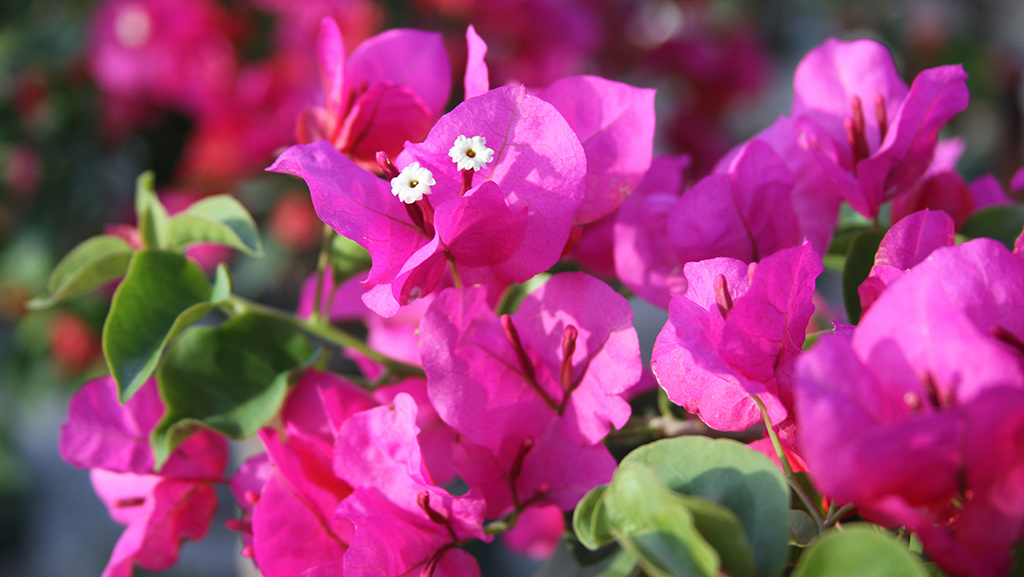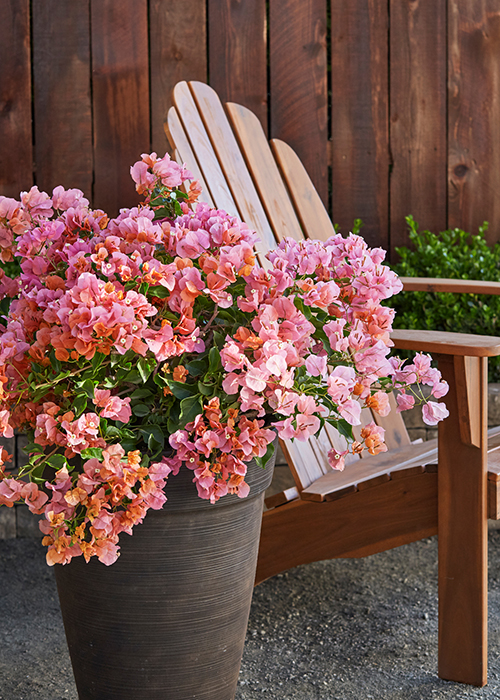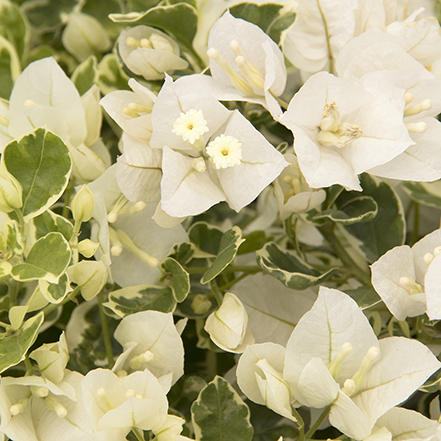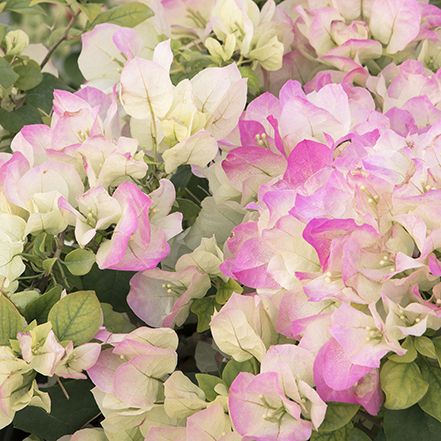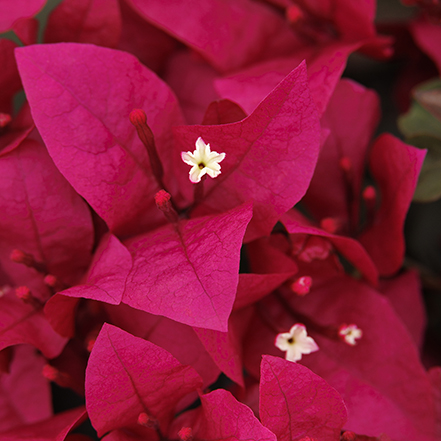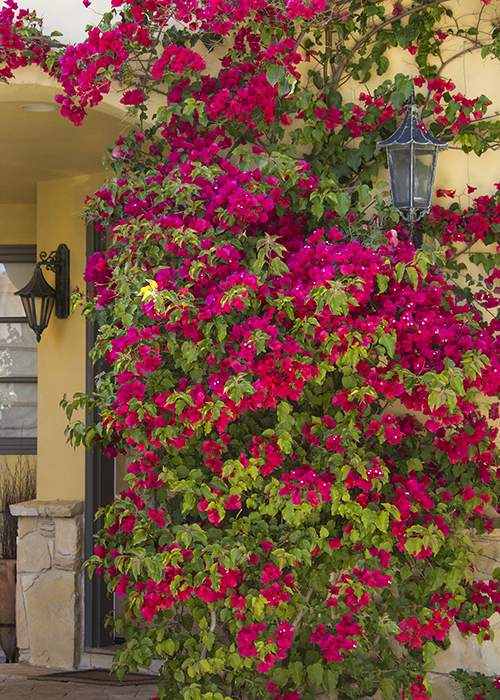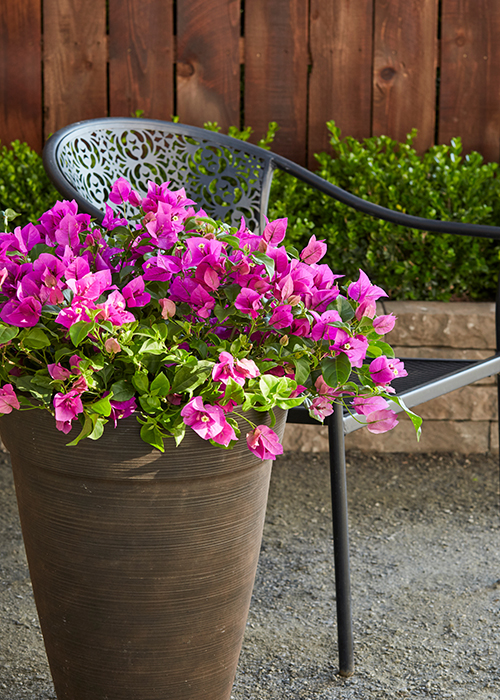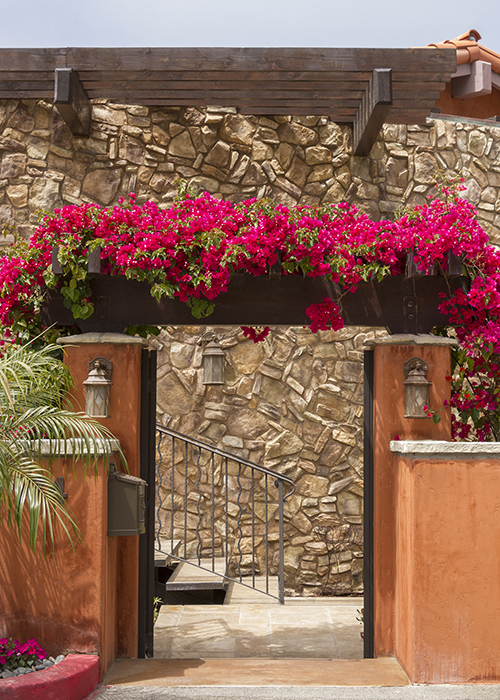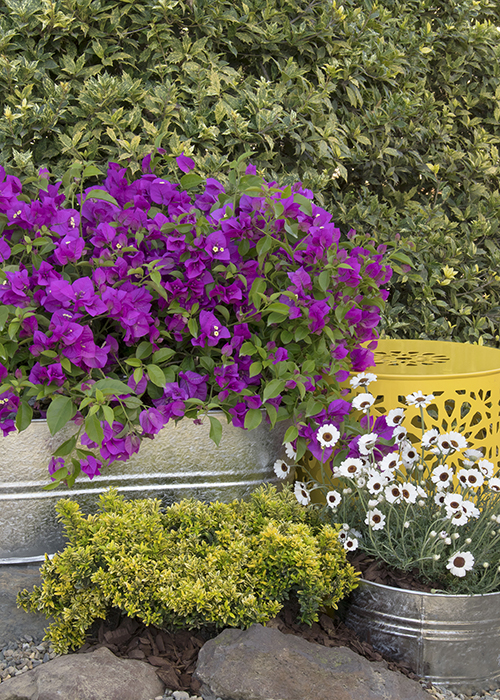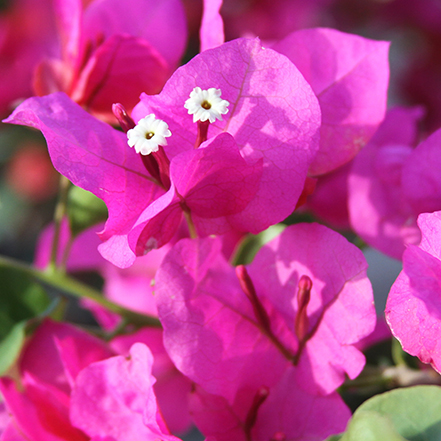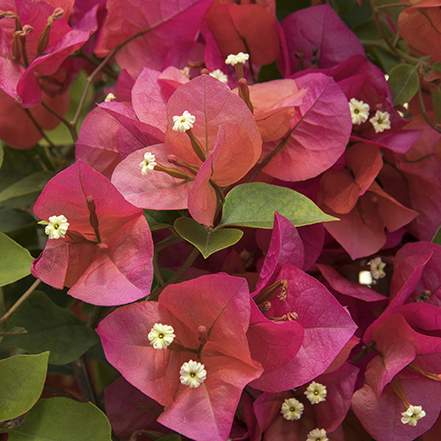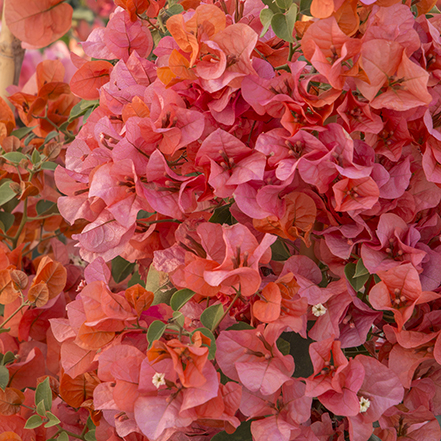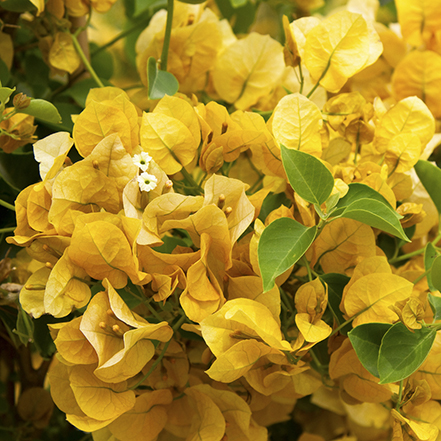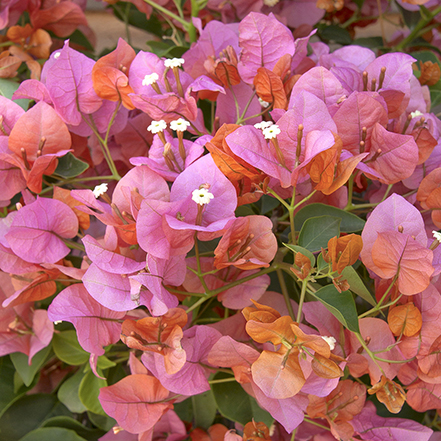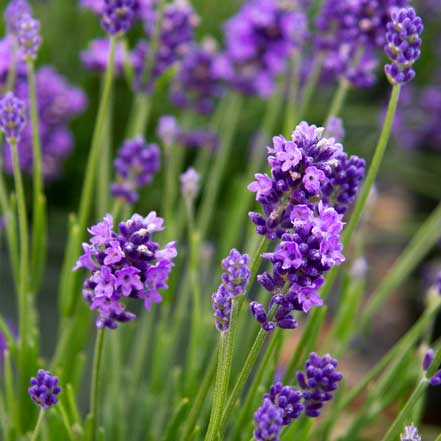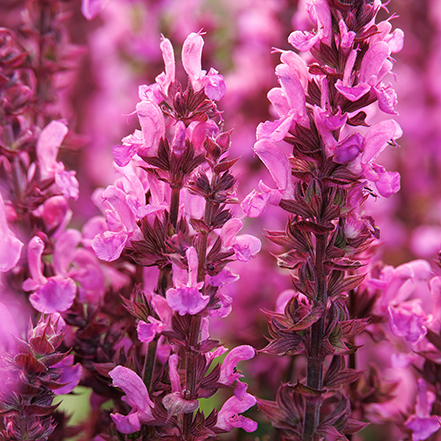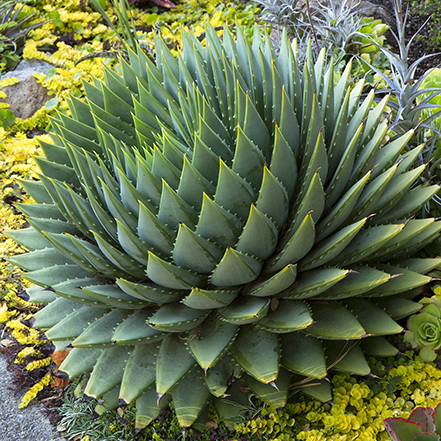Prized for its tropical colors and vibrancy, bougainvillea is grown from coast to coast as a staple in all kinds of gardens. Sometimes called a "flowering machine," bougainvillea is a fast grower that blooms in colors like red, pink, orange, and purple — although its blooms aren't typical "flowers".
The colorful blooms on bougainvillea are actually paper-like, modified leaves (called a bract) that contain bougainvillea's actual flowers, which are quite small, within. Bougainvillea flowers are the small, trumpet-shaped blooms of white and yellow held inside of the colorful bracts.
Bougainvillea is not only colorful, but it's also a versatile, drought-tolerant plant, and pollinator-friendly plant. Sound like a good fit? We'll tell you everything you need to know about adding bougainvillea to your landscape.
What Makes Bougainvillea Great?
Rosenka Bougainvillea looks fantastic in a container.
Native to South America, bougainvillea has captured the hearts of gardeners around the world due to its ability to thrive in a variety of climates, making it an ideal candidate as a perennial vine in tropical and temperate landscapes (Zones 9-11), and as a popular annual nationwide.
Endowed with glossy leaves and vibrant bracts that surround its tiny, inconspicuous flowers, bougainvillea brings magnificent color to landscapes and containers alike. In fact, when grown as a perennial vine in tropical climates, bougainvillea often blooms year-round.
Bougainvillea is also special thanks to characteristics like:
- Versatility: Bougainvillea can be trained as a vine, shrub, or tree, and it can be grown in containers, hanging baskets, or directly in the ground. You'll see bougainvillea frequently used to climb walls or fences in gardens. Even if you live in a region where it freezes, you can still grow bougainvillea in containers and bring it indoors when temperatures drop. However, most gardeners grow it as an annual, getting a new plant to show off every year.
- Drought Tolerance: Once established, this plant is drought-tolerant and requires minimal watering; it's a great candidate for low-water gardens and gardens in regions with water restrictions.
- Incredible Growth: With proper support, some bougainvillea vines can grow up to 40 feet tall! This plant's growth potential makes it a great option for gardeners looking to cover a wall, fence, or arbor with an evergreen beauty.
What are the Different Varieties of Bougainvillea?
Because it is such a showy and easy-to-grow plant, there are tons of varieties of Bougainvillea on the market today. Monrovia alone grows about 20 different varieties of Bougainvillea. Only the best varieties of Bougainvilleas are chosen to be grown by Monrovia, so be sure to look for vigorous, colorful Bougainvilleas in the classic green pot at your local garden center.
Bougainvillea Species and Varieties
Among the numerous bougainvillea species, two stand out for cultivation in home gardens: Bougainvillea spectabilis and Bougainvillea glabra. The best-performing bougainvillea tend to be hybrid varieties, like Purple Queen® and Barbara Karst. Plus, dwarf varieties like Rosenka Bougainvillea, Oo-La-La®, and Rasberry Ice tend to have more of a mounding, spreading habit that is perfect for containers.
White Stripe
Bougainvillea
An example of Bougainvillea spectabilis. One of the most elegant bougainvilleas, featuring clusters of clear white flower-like bracts against pleasing green and white variegated foliage. The strong vine-like habit provides quick cover and a beautiful show throughout the warm season. Zones 9-11; or grow as annual.
Yani's Delight
Bougainvillea
An example of Bougainvillea glabra. Exquisite pink flower-like bracts tinged with white blanket this attractive smaller mounding bougainvillea. Lovely planted against a sunny wall, or in a patio container or hanging basket, where it will provide fantastic color from spring through fall. Zones 9-11; or grow as annual.
Burgundy Queen®
Bougainvillea
An example of a fantastic bougainvillea hybrid. This showy climber provides a double shot of color with every new flush of growth emerging a dramatic dark burgundy, followed by deep burgundy flower-like bracts. Use for a lush tropical effect on arbors, trellises, fences, and containers. Zones 10-11; or grow as annual.
Bougainvillea spectabilis
Known for its large, brightly colored bracts and vigorous growth, Bougainvillea spectabilis stands out as a showstopper. Its bracts are often more vibrant and larger than those of other bougainvillea varieties, making it a popular choice for gardeners wanting a dramatic floral display. B. spectabilis is native to Brazil and is often used to breed new cultivars of bougainvillea because of its growth and vibrancy.
Bougainvillea glabra
Bougainvillea glabra (also native to Brazil) is celebrated for its glossy leaves and a more manageable growth habit. Sometimes called "paper flower," B. glabra is smaller, smoother, and more slender than B. spectabilis, making it a great variety for container growing or smaller gardens.
Bougainvillea peruviana
Bougainvillea peruviana, with its distinct, smaller bracts and slower growth habit, is perfect for those seeking a more natural, less manicured appearance. B. peruviana is native to Peru and is known to be less vigorous than other bougainvillea varieties; it usually requires pruning to promote substantial branching. This variety is resilient in hot, dry locations, tolerating long and sunny summer months.
Bougainvillea hybrids
Bougainvillea hybrids are cultivars of bougainvillea that have been selectively bred for specific traits such as color, size, and growth habit. Some popular bougainvillea hybrid species include gardener favorites like Oo-La-La®, Purple Queen®, Burgundy Queen®, Gold Rush™, Barbara Karst, and many more. Hybrids often produce an abundance of colorful bracts, are long-blooming, and are well-suited for home gardens and containers.
Step-by-Step Guide for Growing Bougainvillea
If bougainvillea sounds like the perfect addition to your garden, here's when, where, and how to plant these flowering beauties. Remember that bougainvillea is a perennial in Zones 9-11, and should be grown as an annual or a tropical plant that is brought indoors in all other zones. Whether you're growing it as a perennial or an annual, this care guide offers everything you need to know about keeping your bougainvillea happy.
(Above) Barbara Karst Bougainvillea is a popular variety thanks to its vigorous, showy vines. Plant it in well-draining soil with full sun and support.
Where to Plant Your Bougainvillea
In the landscape
Bougainvillea's health and blooming are directly influenced by the amount of sunlight it receives—it loves the sun! Ideally, they should get a minimum of 6 full hours of sunlight daily.
Also, consider planting bougainvillea in a spot that offers some protection from the wind (like near a wall or fence), as harsh winds can break its branches.
Bougainvillea needs well-draining soil to prevent root rot. And remember, depending on the variety, this plant can get pretty tall and sprawling. Choose a spot in your garden where bougainvillea can grow and thrive freely without crowding other plants.
In a Container
Similarly, when planting a bougainvillea in a container, it's crucial to select a pot with good drainage holes to prevent waterlogging. Use a well-draining potting mix and position the container in a sunny spot. Consider providing support or a trellis for the bougainvillea to climb.
When To Plant Bougainvillea
The best time to plant is during the spring or early summer, once the threat of frost has passed. This timing lets the plant establish its root system before the heat of the summer months and ensures it has plenty of time to grow strong before facing potential cold in later seasons. In regions with mild winters, bougainvillea can also be planted in the fall, providing a mild winter that allows for continued root development.
Planting Bougainvillea
- Prepare the Soil: Loosen your soil to a depth of 12-20 inches. Mix compost or other organic material into your planting bed to enhance soil fertility and drainage.
- Root Ball Care: Gently tease the root ball before planting to encourage roots to spread out in their new environment. Once you place the plant, backfill the hole with soil and firm it around the root ball to avoid air pockets.
- Watering: After planting, water your bougainvillea thoroughly to settle the soil around the roots. You can also add a layer of mulch around the base of your bougainvillea to suppress weeds.
- Tie the Plant: If you're growing bougainvillea as a vine, tie the plant to a support structure. You can use plant ties or soft fabric strips to do so.
How to Care for Bougainvillea Plants
Whether your bougainvillea is planted in the landscape or a container, follow these care tips to keep it thriving and blooming.
(Above) Purple Queen® Bougainvillea looks fabulous in a container or hanging basket.
Watering Bougainvillea Plants
During its establishment period, bougainvillea needs regular and deep watering, but be sure to let it dry out slightly between waterings. Bougainvillea does not like consistently wet soil.
Take note of the conditions when considering whether or not to water your bougainvillea— in extremely hot and dry climates, bougainvillea will need to be watered more frequently. However, if you water bougainvillea too much, you'll notice that you won't get as many flowers and colorful bracts. Reduce watering in the winter months to avoid root rot.
Once it's established, your bougainvillea is drought tolerant.
Sunlight
To encourage your bougainvillea to be a flowering machine, it needs at least 6 hours of direct sunlight daily. If you notice your bougainvillea isn't producing much color or blooms, it's probably being blocked from the sun by another plant or structure in your garden. It's common for garden designs to incorporate bougainvillea in sunny spots against walls, over arbors, or in hanging baskets to take full advantage of its growth habit.
Fertilizing Bougainvillea Plants
Bougainvillea appreciates occasional feeding to promote healthy growth and abundant flowering, but consistent fertilizing is not a necessity. If you choose to feed your bougainvillea, use a balanced, slow-release fertilizer once during the growing season, or consider a bougainvillea-specific fertilizer.
Follow the manufacturer's instructions for applying fertilizer; bougainvillea won't need feeding in the winter when its growth naturally slows.
Bougainvillea Pruning: When and How to Do It Right
Pruning is crucial for shaping the plant, encouraging new growth, and ensuring abundant blooms. The best time to prune bougainvillea is typically in late winter or early spring. Avoid pruning bougainvillea in the fall as the foliage protects the plant from cold damage.
Here are some pruning tips to keep in mind:
- Use clean, sharp pruning shears to make precise cuts.
- Remove any dead, damaged, or diseased branches first to maintain plant health. Then, trim back the tips of the plant to encourage new growth.
- Shape the plant according to your garden designs, whether you're aiming for a sprawling shrub, a climbing vine, or a neatly contained pot plant.
Pruning bougainvillea supports its health and paves the way for a flourish of blooms in the following season.
Garden Design Ideas for Bougainvillea
(Above) Barbara Karst Bougainvillea makes a dramatic statement when grown over an arbor.
(Above) Purple Queen® Bougainvillea's deep purple bracts look fabulous in a metal container, especially when combined with other plants like euonymus and daisy.
(Above) Orange King Bougainvillea pops in this waterwise container filled with the silver-green foliage of Mountain Everest Big Blue Chalksticks, Eucalyptus, and the deep red of SunSparkler® Dream Dazzler Sedum.
Bougainvillea's versatile growth habit makes it a spectacular addition to any garden design. Now that you know how to care for this flowering machine, it's time to get the gears turning with ideas for bougainvillea placement in your garden. Here's some inspiration to get you started:
- Train bougainvillea to climb trellises or arbors as part of an inviting entryway or garden focal point.
- Use as ground cover in sunny areas where you desire quick spreading and vibrant color.
- Plant alongside fences or walls for a natural, vividly colored privacy screen.
- Position in full sun areas of your patio or deck in decorative pots for striking seasonal displays.
Best Bougainvillea Varieties for Vibrant, Unique Color
Oo-La-La®
Bougainvillea
Vibrant, magenta-red flowers that bloom longer than most bougainvilleas. The compact, dwarf form is wonderful for cascading over hanging baskets, or as a spreading groundcover. Try it in patio tree form to create a stunning accent to landscapes and container gardens. Up to 2' tall, 8' wide. Zones 10-11; or grow as annual.
Purple Queen®
Bougainvillea
Rich, deep purple, petal-like bracts are displayed against handsome, deep green foliage. A wonderful compact, upright and spreading form that works well in planter boxes, and on fences and arbors. Up to 15' tall with support; or 2' tall, 8' wide as groundcover.
Camarillo Fiesta®
Bougainvillea
A quick, splendid cover with an interesting mix of showy, flower-like bracts that range from hot pink to gold. Creates a beautiful display on an arbor or trellis, or in containers, especially as an annual Up to 30' with support. Zones 10-11; or grow as annual.
Orange King
Bougainvillea
A unique stunner with showy masses of bronze-orange and pink flowers. Perfect as an annual in patio containers and hanging baskets, or as a tropical plant that vigorously gorws over arbors, trellises, and fences. Up to 30' tall with support. Zones 10-11; or grow as annual.
Gold Rush™
Bougainvillea
Clear of any orange or pink tones, the profuse golden yellow flowers are brighter than other varieties, and offer warm, versatile color that combines well with any flower or structure color. Use as a summer annual in patio containers or hanging baskets. Up to 30' tall with support. Zones10-11; or grow as annual.
Rosenka
Bougainvillea
A profusely blooming selection that boasts rich gold-colored flower-like bracts that age to a lovely pink. Features an exceptionally dwarf, mounding habit that is great for small spaces, containers, or borders. Up to 2' tall, 4' wide. Zones 10-11; or grow as annual.
Companion Plants for Bougainvillea
As you decide on the perfect spot for your bougainvillea, you'll want to consider companion plants that can complement its beauty while coexisting peacefully. Ideal bougainvillea companions share similar care requirements but offer contrasting textures, heights, or colors to create an engaging landscape.
Drought-tolerant plants, such as lavender, salvia, and succulents, make excellent companions, sharing bougainvillea's need for full sun, well-draining soil, and moderate-to-little watering.
Thumbelina Leigh
English Lavender
An extremely aromatic and profuse bloomer, this compact selection produces lovely spikes of violet-blue blooms up to three times per year! Prune back by one-half after flowering for the best repeat show. Full sun. Zones 5-9.
Rose Marvel
Salvia
Vibrant blooms on a compact form, perfect for the middle to the front of a sunny border. Ultra-large, rose-pink flower spikes top upright stems of gray-green, deer and rabbit-resistant foliage. Reblooms without being cut back! Full sun. Up to 12" tall and wide. Zones 4-9.
Get More Plant Care Tips and Guides
- Sign up for the Grow Beautifully Newsletter. You'll get gardening tips, design advice, free digital guides, and live webinar invites. Plus, new, exclusive plant information delivered straight to your inbox twice a month.
- Hibiscus Care Guide
- Conifer Care Guide
- Boxwood Winter Care
- Azalea Care Guide
- Hydrangea Care Guide
- Top 10 Tips for Planting in Summer
- How to put Hydrangeas to Bed for Winter
- Our Top 10 Gardening Tips
- Guide to Pruning Flowering Shrubs
- How and When to Prune Hydrangeas
- Pruning Ornamental Grasses
- How and When to Prune Lavender
- Check out the "Garden Tips" section of the blog. Here there are care guides and garden tips on a wide array of plants.





